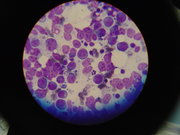 Lymphoma in a Golden Retriever
Lymphoma in a Golden Retriever
|
From Wikipedia the free encyclopedia, by MultiMedia |
Lymphoma in animals is a malignant cancer originating from lymphocytes, which are an important component of the immune system. Lymphoma also occurs in humans. The disease occurs in lymph nodes, bone marrow, and organs such as the liver, spleen, eye, skin, and gastrointestinal system. It is also known as lymphosarcoma.
 Lymphoma in a Golden Retriever
Lymphoma in a Golden Retriever
 Cytology of lymphoma in a dog
Cytology of lymphoma in a dog
Lymphoma is one of the most common malignant tumors to occur in dogs. The cause is genetic, but there also suspected environmental factors involved.
The cancer is classified into low and high grade types. Classification is also based on location. The four location types are multicentric, mediastinal, gastrointestinal, and extranodal (involving the kidney, central nervous system, skin, heart, or eye). Multicentric lymphoma, the most common type, is found in the lymph nodes, with or without involvement in the liver, spleen, or bone marrow. Mediastinal lymphoma occurs in the lymph nodes in that area and possibly the thymus. Gastrointestinal lymphoma occurs as either a solitary tumor or diffuse invasion of the stomach or intestines, with or without involvement in the surrounding lymph nodes, liver or spleen. Classification is further based on involvement of B-lymphocytes or T-lymphocytes.
General symptoms include depression, fever, weight loss, loss of appetite, and vomiting. Hypercalcemia (high blood calcium levels) occurs in some cases of lymphoma, and can lead to the above symptoms plus increased water drinking, increased urination, and arrhythmias.
Multicentric lymphoma presents as painless enlargement of the peripheral lymph nodes. This is seen in areas such as under the jaw, the armpits, the groin, and behind the knees. Enlargement of the liver and spleen causes the abdomen to distend. Mediastinal lymphoma can cause fluid to collect around the lungs, leading to coughing and difficulty breathing. Hypercalcemia is most commonly associated with this type. Gastrointestinal lymphoma causes vomiting, diarrhea, and melena (digested blood in the stool).
Lymphoma of the skin is an uncommon occurrence. An important type originating from T-lymphocytes is mycosis fungoides. It can have a wide variety of appearances, from a single lump to large areas of bruised, ulcerated, hairless skin.
Symptoms for lymphoma in other sites depend on the location. Central nervous system involvement can cause seizures or paralysis. Eye involvement can lead to glaucoma, uveitis, bleeding within the eye, retinal detachment, and blindness. Lymphoma in the bone marrow causes anemia, low platelet count, and low white blood cell count.
Biopsy of affected lymph nodes or organs confirm the diagnosis. X-rays, ultrasound, blood analysis, amd bone marrow biopsy reveal other locations of the cancer. The stage of the disease is important to treatment and prognosis.
Each stage is divided into those with systemic symptoms (loss of appetite, weight loss, etc.) and those without.
Complete cure is rare with lymphoma, but long remission times are possible with chemotherapy. With effective protocols, average first remission times are 6 to 8 months. Second remissions are shorter and harder to accomplish. Average survival is 9 to 12 months. The most common treatment is a combination of cyclophosphamide, vincristine, prednisone, L-asparaginase, and doxorubicin. Other chemotherapy drugs such as chlorambucil, lomustine (CCNU), cytosine arabinoside, and mitoxantrone are sometimes used in the treatment of lymphoma by themselves or in substitution for other drugs. In most cases, appropriate treatment protocols cause few side effects, but white blood cell counts must be monitored.
When cost is a factor, prednisone used alone can improve the symptoms dramatically, but it does not significantly affect the survival rate. The average survival times of dogs treated with prednisone and untreated dogs are both one to two months. Using prednisone alone can cause the cancer to become resistant to other chemotherapy agents, so it should only be used if there is definitely no chance of further treatment.
Lymphoma with a histologic high grade generally respond better to treatment. Dogs with B-lymphocyte tumors have a longer survival time than T-lymphocyte tumors. Mediastinal lymphoma has a poorer prognosis than other types. Otherwise, the stage of the disease is the best prognostic factor.
Lymphoma in young cats occurs most frequently following infection with feline leukemia virus (FeLV) or to a lesser degree feline immunodeficiency virus (FIV). These cats tend to have involvement of lymph nodes, spine, or mediastinum. Cats with FeLV are 62 times more likely to develop lymphoma, and cats with both FeLV and FIV are 77 times more likely. Older cats tend to have gastrointestinal lymphoma without FeLV infection. The same forms of lymphoma that are found in dogs also occur in cats, but gastrointestinal is the most common type. Lymphoma of the kidney is the most common kidney tumor in cats, and lymphoma is also the most common heart tumor.
Symptoms for multicentric, mediastinal, and extranodal lymphoma are similar to dogs, except hypercalcemia is rare. The most common sites for gastrointestinal lymphoma are, in decreasing frequency, the small intestine, the stomach, the junction of the ileum, cecum, and colon, and the colon. Symptoms include vomiting, diarrhea, weight loss, loss of appetite, and melena. The tumor can also cause life-threatening blockage of the intestine. Anemia is a common problem in all cats with lymphoma. Lymphoma of the kidney presents as bilateral kidney enlargement and failure. Lymphoma of the heart causes congestive heart failure, pericardial effusion, and arrhythmias.
Diagnosis is similar to dogs, except cats should be tested for FeLV and FIV.
Chemotherapy is the mainstay of treatment for lymphoma in cats. Most of the drugs used in dogs are used in cats, but the most common protocol uses cyclophosphamide, vincristine, and prednisone. The white blood cell count must be monitored. Remission and survival times are comparable to dogs. Lower stage lymphoma has a better prognosis. Multicentric lymphoma has a better reponse to treatment than the gastrointestinal form, but infection with FeLV worsens the prognosis.
Lymphoma is common in ferrets and is the most common cancer in young ferrets. There is some evidence that a retrovirus may play a role in the development of lymphoma like in cats. The most commonly affected tissues are the lymph nodes, spleen, liver, intestine, mediastinum, bone marrow, lung, and kidney.
In young ferrets, the disease progresses rapidly. Symptoms include loss of appetite, weight loss, weakness, depression, difficulty breathing, and coughing. It can also masquerade as a chronic disease such as an upper respiratory infection or gastrointestinal disease. In older ferrets, lymphoma is usually chronic and can exhibit no symptoms for years. Symptoms seen are the same as in young ferrets, plus splenomegaly, abdominal masses, and peripheral lymph node enlargement.
Diagnosis is through biopsy and x-rays. There may also be an increased lymphocyte count. Treatment includes surgery for solitary tumors, splenectomy (when the spleen is very large), and chemotherapy. The most common protocol uses prednisone, vincristine, and cyclophosphamide. Doxorubicin is used in some cases. Chemotherapy in relatively healthy ferrets is tolerated very well, but possible side effects include loss of appetite, depression, weakness, vomiting, and loss of whiskers. The white blood cell count must be monitored. Prednisone used alone can work very well for weeks to months, but it may cause resistance to other chemotherapy agents. Alternative treatments include vitamin C and Pau d'Arco (a bark extract).
The prognosis for lymphoma in ferrets depends on the their health and the location of the cancer. Lymphoma in the mediastinum, spleen, skin, and peripheral lymph nodes has the best prognosis, while lymphoma in the intestine, liver, abdominal lymph nodes, and bone marrow has the worst.
Cats, made by MultiMedia | Free content and software
This guide is licensed under the GNU Free Documentation License. It uses material from the Wikipedia.